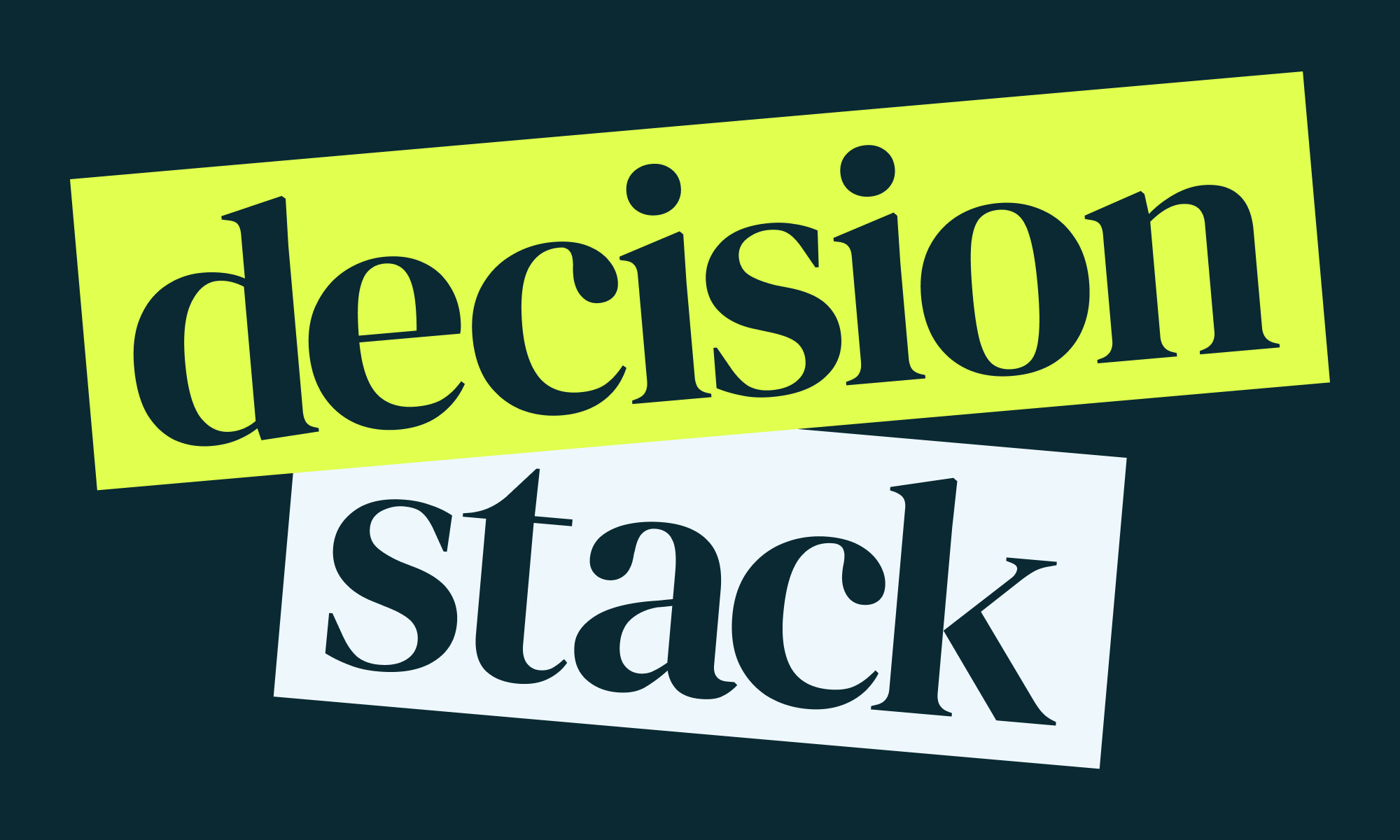My Strategy Toolkit
There is no one right way to do strategy - but there are lots of definitions, frameworks, and tools that can help you craft a successful strategy.
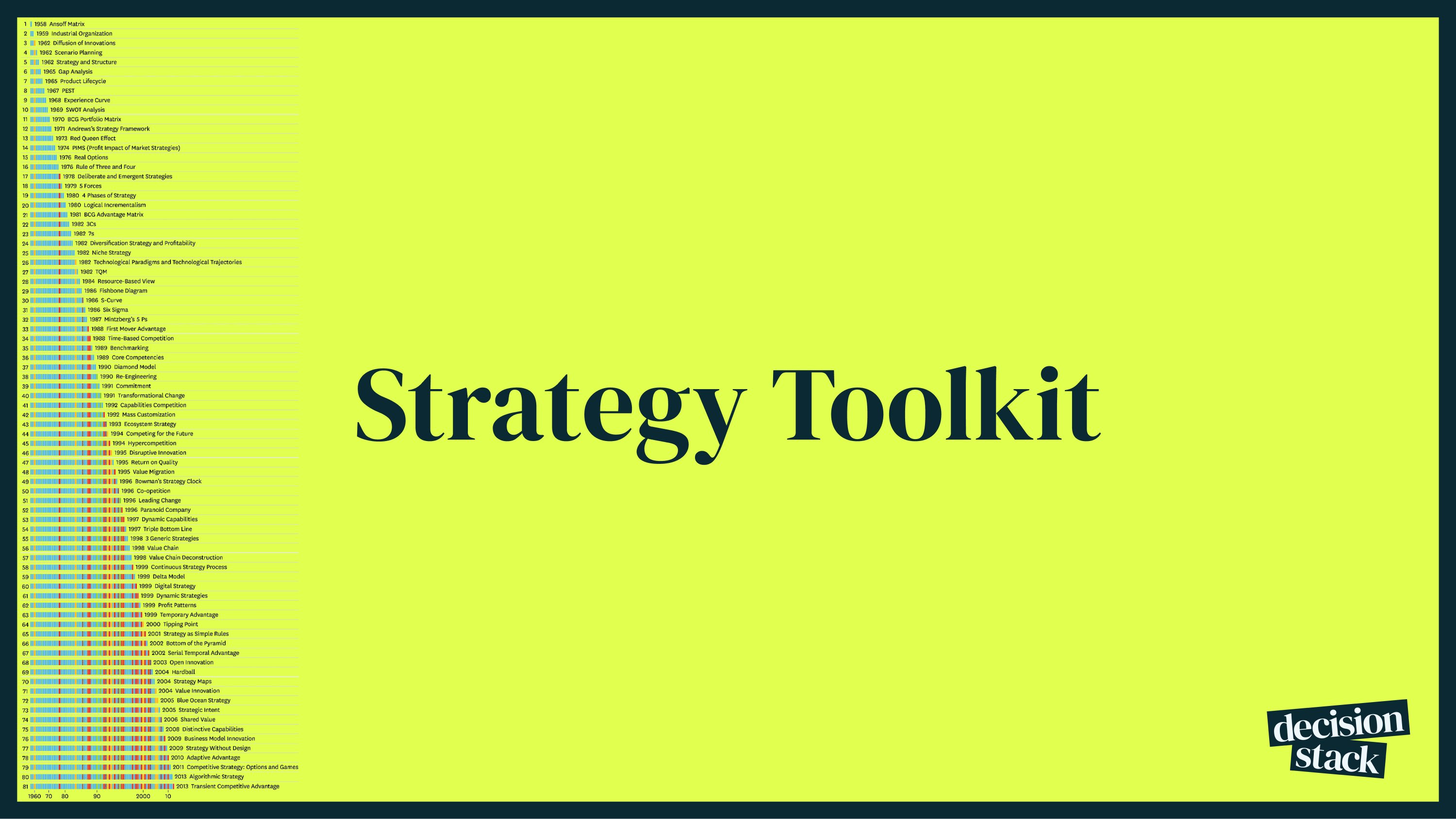
While there is no one right way to do strategy, there are *a lot* of definitions and frameworks out there that can help you and your team design a strategy. And there are even more tools you can use to analyse your situation, understand the challenge in front of you, and design and test any strategic hypotheses you develop in the process.
The key isn’t to use every single tool every single time - but to know you have a deep toolkit you can reach into for the appropriate option when faced with a challenge or question to resolve.
My Toolkit
- Before you Start
- Strategy Definitions/Books
- How I Approach Strategy
- Tools to Understand Where You Are Today
- Tools to Design Strategic Hypotheses
- Tools to Test Strategic Hypotheses
Before you Start
Before you tackle any strategy it’s worth asking yourself a few key questions;
- Are you looking at the right strategy level? If you’re tasked with creating product strategy, marketing strategy, technology strategy, or another function focused strategy it’s imperative that you first zoom out and double check the company strategy. And if there isn’t one - or it isn’t clear enough - you have to work with the rest of your organisation to fix that first. There is no point trying to design a marketing strategy if the company strategy isn’t clear…
- Who needs to be involved? Great strategy is rarely done in an ivory tower so think about who should be in the conversation from the start, who needs to be a decision maker, and who just needs to be informed. Quickly jotting down a RACI (Responsible, Accountable, Consulted, Informed) matrix might help.
- Do we all have the same definition of strategy? It’s such a loaded term that once you gather your team you will rarely have a shared understanding of strategy. It’s worth spending some time agreeing what strategy is - and what problem you need it to solve in your organisation.
And for a bonus - read my definition of strategy, including where most organisations go wrong.
Strategy Definitions/Books
Strategy is a muscle, and to train that muscle it’s important to learn as much as possible from all the different schools of thought out there on strategy. Here are some of my favourites:
Strategy Safari
Strategy Safari is a comprehensive exploration of various schools of thought in strategic management. Written by Henry Mintzberg, Bruce Ahlstrand, and Joseph Lampel, the book is a meta study of sorts - presenting ten distinct schools of strategic management, each offering unique perspectives on different approaches to understanding and formulating strategy, ranging from classical to evolutionary, processual, and more. Throughout the book, the authors provide insights into the key concepts, methodologies, and thinkers associated with each school. While it is a little academic in its approach, the book encourages you to explore and integrate various perspectives to develop a more holistic understanding of strategy. As usual - it’s not about picking one school, but taking the best from each.
Competitive Strategy
Competitive Strategy by Michael Porter is a seminal work in the field of strategic management. In this book, he introduces the concept of competitive advantage and outlines the fundamental principles of strategic positioning. He argues that companies can only truly achieve sustainable competitive advantage by either differentiating their products or services to command higher prices or by achieving lower costs than their competitors. While this might seem basic today, it’s still fundamental and it’s the book that launched strategy as a business science.
Good Strategy/Bad Strategy
Good Strategy/Bad Strategy by Richard Rumelt provides a concise and insightful exploration of what distinguishes effective strategy from ineffective ones. He argues that good strategy begins with a clear diagnosis of the problem or challenge at hand, followed by a coherent plan of action that leverages the organisation’s strengths while addressing critical obstacles. He emphasises the importance of focusing on the core elements of strategy rather than relying on superficial goals or slogans, and he illustrates his points with numerous real-world examples from business, military, and political arenas.
Playing to Win
Playing to Win by A.G. Lafley and Roger L. Martin offers a strategic framework for businesses seeking to achieve sustainable success. They argue that effective strategy is about making clear choices and focusing on winning in the marketplace. They introduce five key strategic choices: What is your winning aspiration? Where will you play? How will you win? What capabilities must be in place? and What management systems are required? (More on this framework below) Through compelling case studies from Procter & Gamble, where Lafley served as CEO, and other companies, the book illustrates how these choices drive successful strategy execution. By emphasising the importance of clarity, coherence, and consistency in strategic decision-making, Playing to Win provides an excellent blueprint for successful strategy in the real world.
How I Approach Strategy
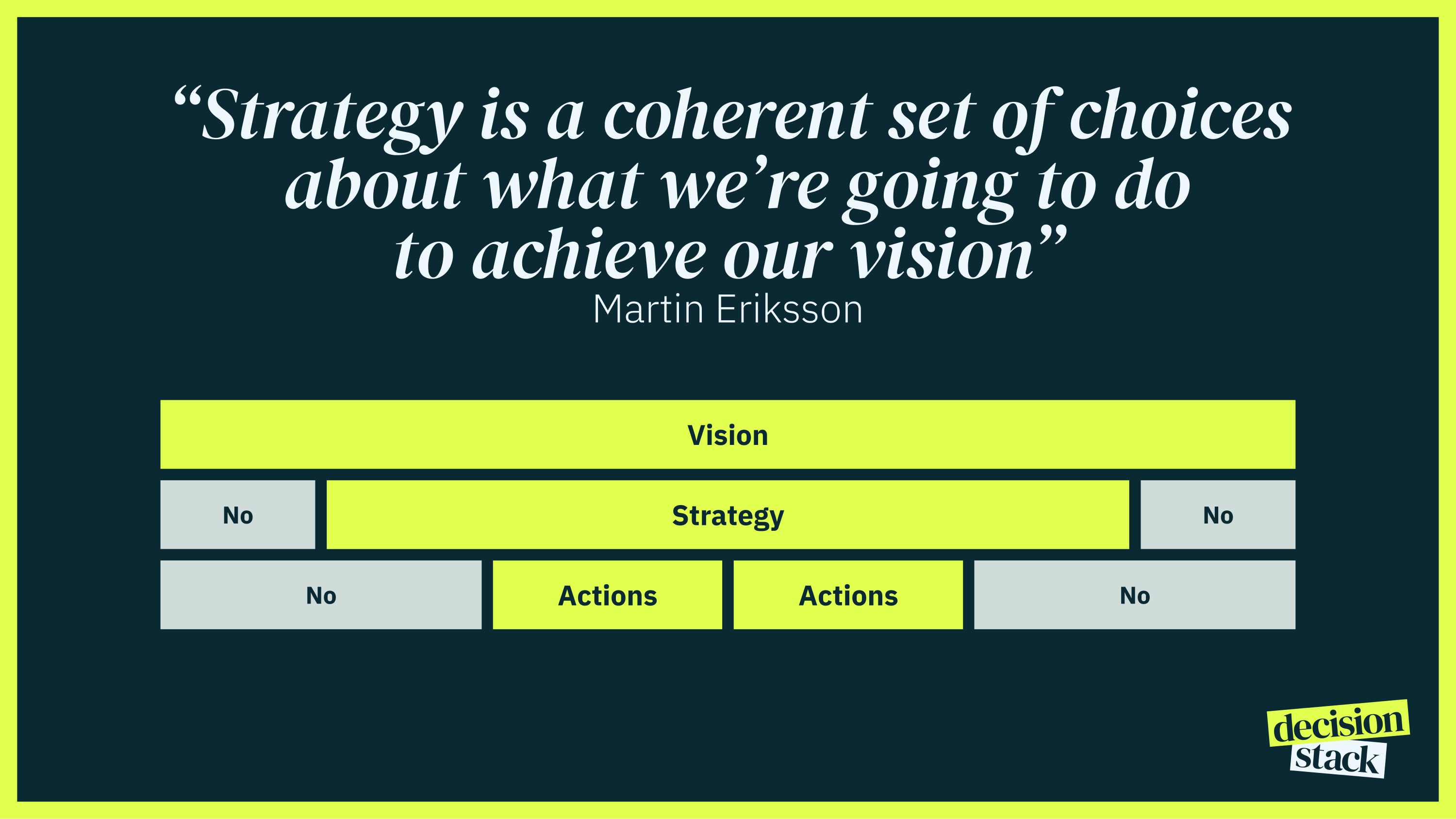
Building on all the giants above, I define strategy as “a coherent set of choices about what we’re going to do to achieve our vision” so I like to work through strategy from the top down:
- Start with a vision and a challenge
- Be honest about where you are today - the state of your business and market
- Design a hypothesis on how to bridge the gap from where you are to where you want to be
- Make a coherent set of choices about how you will do that
You can also challenge strategy from the bottom up, but it’s important to always centre your strategy on what you’re trying to achieve and how you want to get there.
Tools to Understand Where You Are Today
By definition, defining your vision and mission is so specific to you and your organisation that there are no tools or templates that will help. Once you get into analysing the state of your business and market, however, there are lots. Here are some of my favourites:
Map your business: SWOT
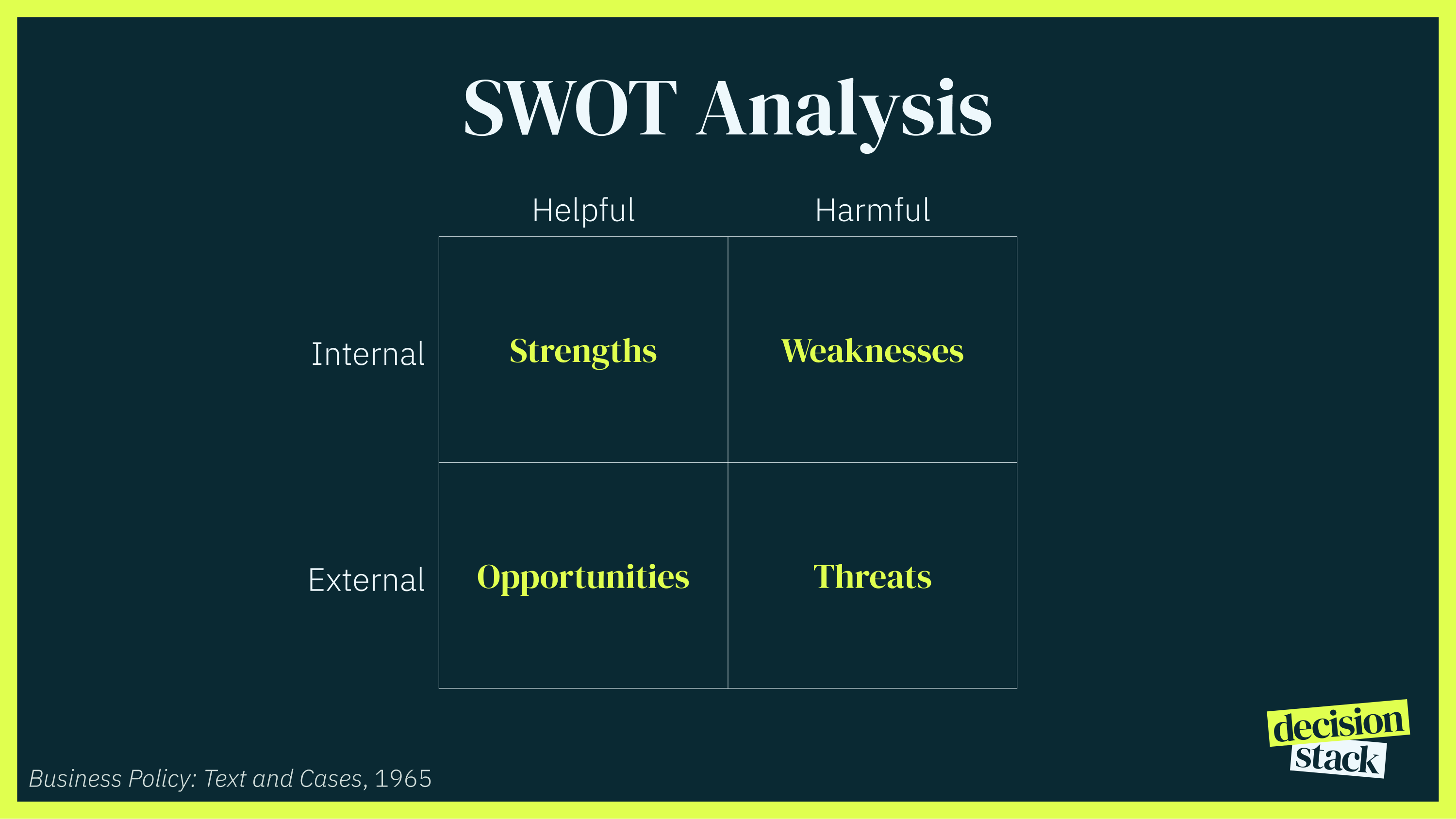
SWOT analysis is a strategic planning tool used to identify and evaluate the Strengths, Weaknesses, Opportunities, and Threats related to a business or project. Strengths and weaknesses are internal factors, focusing on what the organisation does well and where it may struggle. Opportunities and threats are external factors, highlighting potential areas for growth or challenges posed by the environment. By systematically assessing these elements, you can have an honest understanding of where you are - and that will let you develop informed strategies that leverage your strengths, mitigate your weaknesses, capitalise on your opportunities, and address your threats.
Understand your market: 5 Forces
Michael Porter’s Five Forces is a framework for analysing the competitive dynamics within an industry. It assesses five key factors that influence an organisation's profitability and market position:
- Competitive Rivalry among existing firms, which measures the intensity of competition
- Threat of New Entrants, evaluating how easily new competitors can enter the market
- Bargaining Power of Suppliers, determining how much influence suppliers have on costs and availability
- Bargaining Power of Buyers, assessing the power of customers to affect pricing and quality
- Threat of Substitutes, which looks at the availability of alternative products or services.
Together, these forces help businesses understand their competitive environment and shape their strategic decisions.
Understand the world around you: PESTLE
The PESTLE model is a strategic tool used to analyse the external macro-environmental factors that might impact an organisation. It stands for Political, Economic, Social, Technological, Legal, and Environmental factors. By examining these areas, businesses can identify potential risks and opportunities that could affect their operations and strategy. It's often used in strategic planning to ensure that decision-makers consider a wide range of external influences and stay adaptable to changes in the external environment.
Understanding your business levers
It is absolutely fundamental that you understand your own business levers. What is your funding model? What is your runway? What is your business model? What are the major levers that impact that business model? It’s surprising how often this gets overlooked in a strategic process but your focus is going to be very different if you’re a non-profit vs a venture capital backed startup, have 6 months runway left or you’re already profitable, etc.
Portfolio Management: the 9-box Matrix
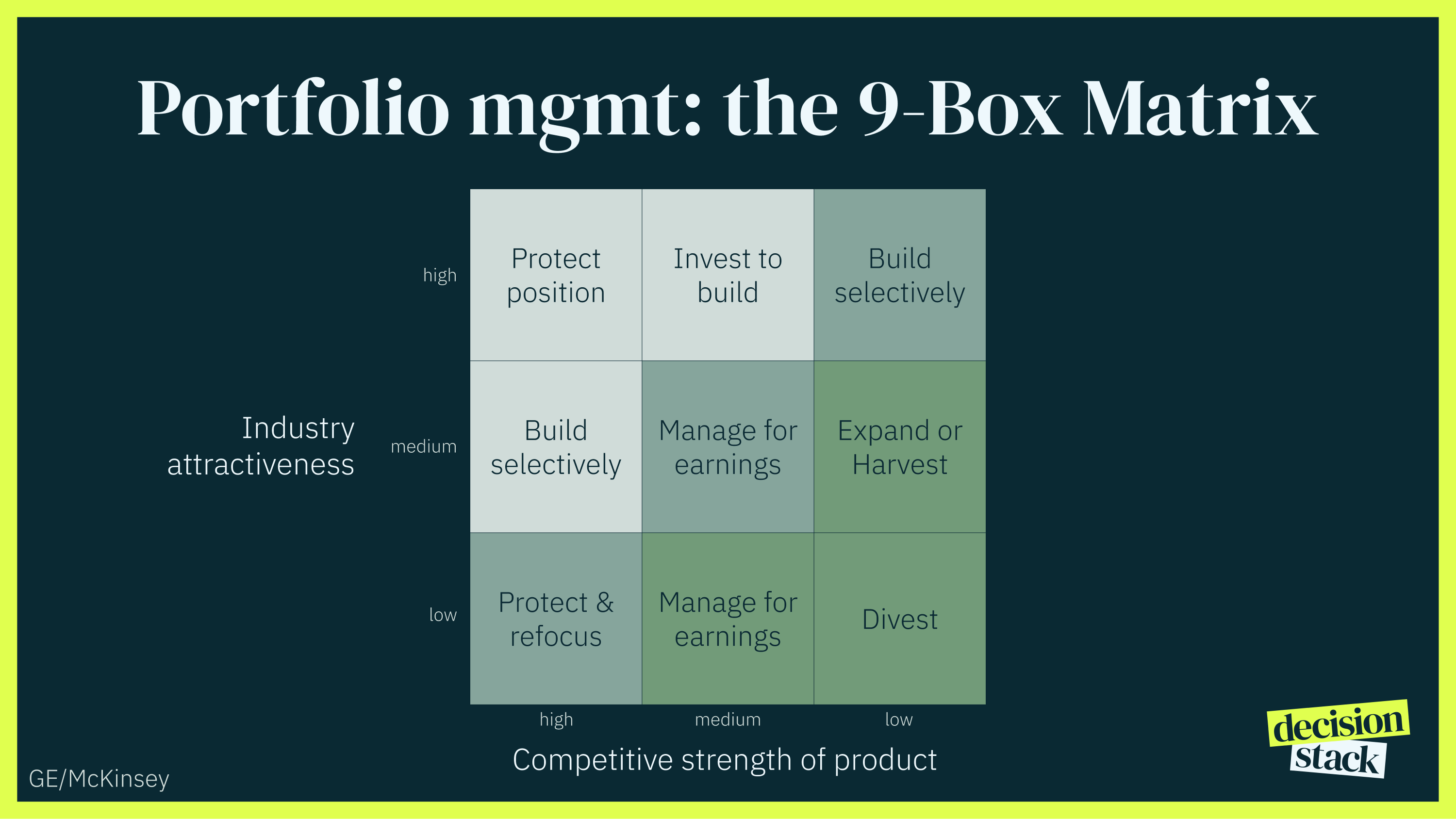
The GE/McKinsey 9-box matrix is a strategic tool used for portfolio analysis and resource allocation across a company's products or business units. It features a grid that assesses two dimensions: the attractiveness of the market and the competitive strength of the business unit or product. Each axis is divided into three levels (high, medium, low), resulting in nine boxes that help guide a decision on what to do with that unit/product. This can help organisations prioritise where to focus and invest, identify growth opportunities, and make strategic decisions by visualising where each unit/product stands in terms of both market potential and competitive position.
Know your ocean: Blue Ocean Strategy
Blue Ocean Strategy describes the value of creating uncontested market spaces, or "blue oceans," rather than competing in crowded markets, or "red oceans," where competition is fierce and often leads to price wars. A blue ocean strategy encourages companies to innovate and differentiate their offerings, focusing on value creation for both the business and its customers. By identifying new demand and crafting unique products or services, organisations can unlock new market opportunities and achieve sustainable growth, thereby making competition irrelevant. The most important thing for me is simply acknowledging whether you’re in a red ocean or have the potential to create a blue ocean - because you have to act very differently depending on which one you're in.
How can you differentiate: 7 Powers
Hamilton Helmer's book 7 Powers identifies seven distinct sources of competitive advantage that can help businesses achieve lasting success. These powers are:
- Scale Economies, where larger companies can reduce costs
- Network Economies, which leverage user connections to increase value
- Counter-Positioning, where a new entrant's offering is superior to that of incumbents
- Switching Costs, making it difficult for customers to change providers
- Branding, which creates loyalty and perceived value
- Cornered Resource, controlling a unique asset that others cannot access
- Process Power, optimising operations to deliver superior products or services
By understanding and harnessing these powers, you can build a robust competitive position and sustain long-term profitability.
Where should you invest: Kano Model
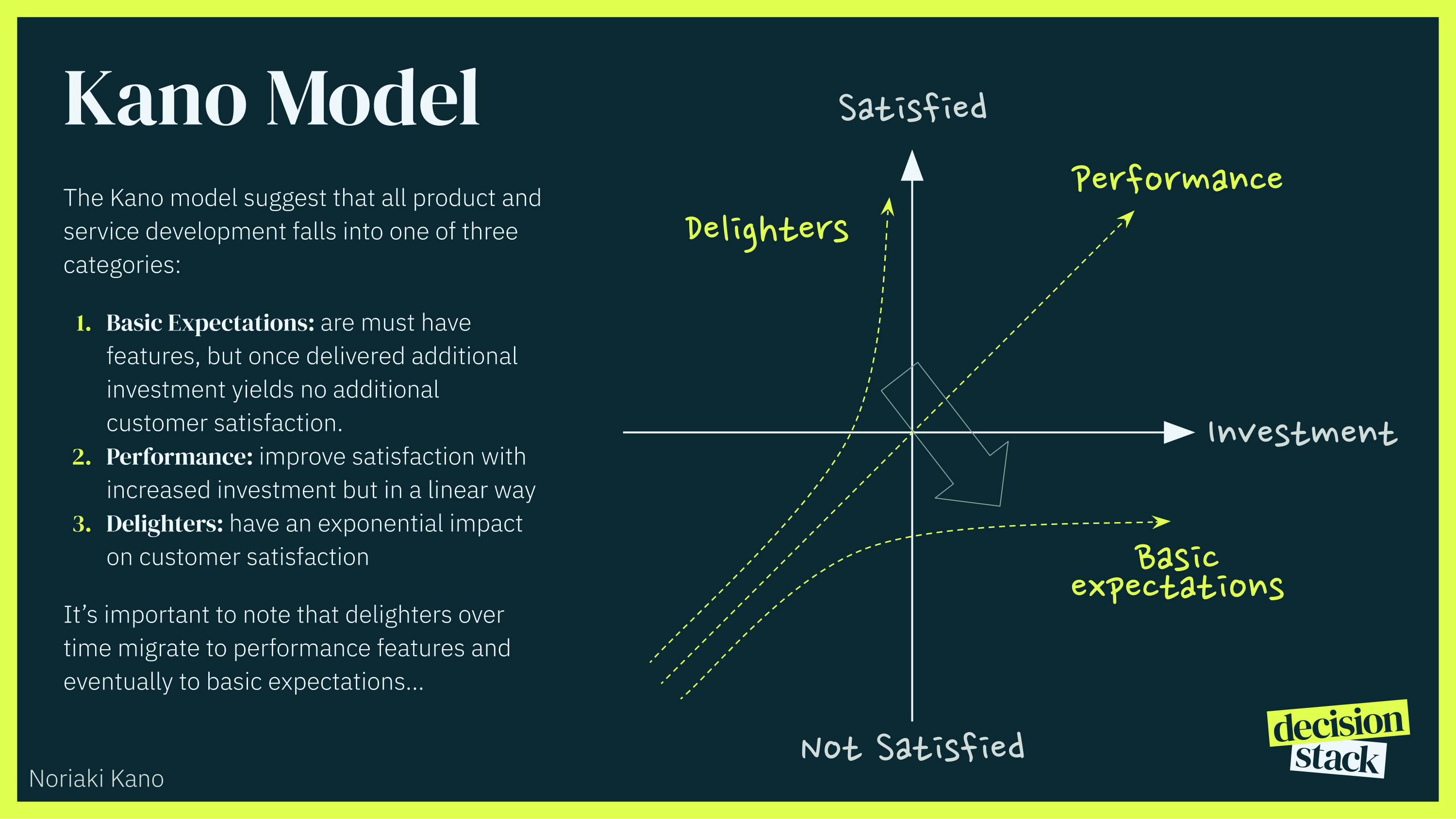
The Kano model is a framework used to prioritise customer needs and enhance product development by categorising features based on their impact on customer satisfaction. Developed by Professor Noriaki Kano, the model classifies product attributes into five categories:
- Basic Needs, which are essential and must be met;
- Performance Needs, where satisfaction increases with better performance;
- Excitement Needs, which can delight customers when fulfilled but do not cause dissatisfaction if unmet;
While used more rarely, the Kano model also highlights Indifferent Needs, which have little impact on satisfaction; and Reverse Needs, where higher performance may lead to dissatisfaction.
By understanding these categories of needs, you can more effectively allocate resources to products that maximize customer satisfaction and loyalty.
Tools to Design a Strategic Hypothesis
Here are my two favourite frameworks for developing a strategy - though there are others! Which one you choose isn’t important - as long as it resonates with you and your team, and helps you tackle the strategic challenge in front of you:
The Good Strategy/Bad Strategy Kernel
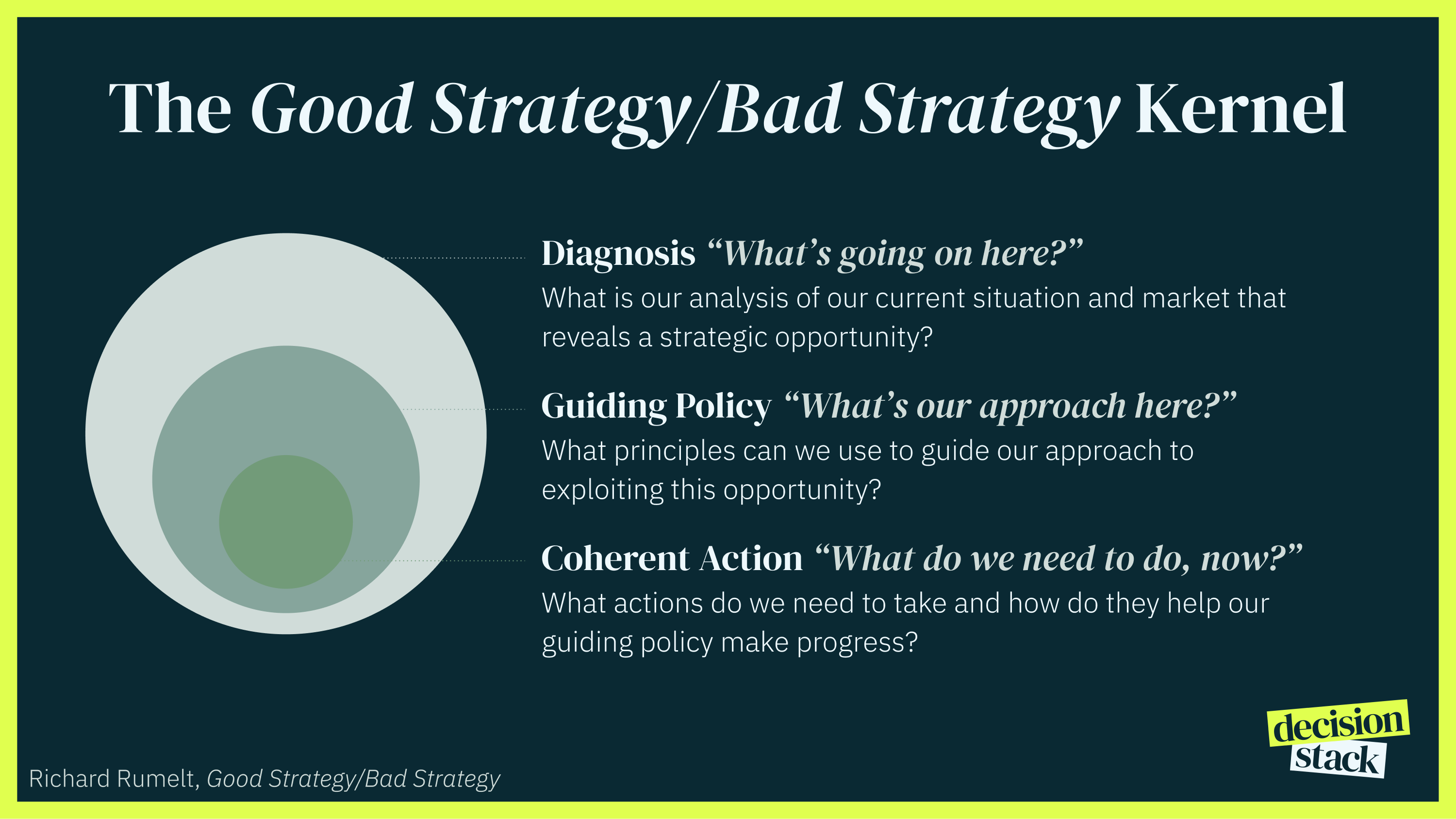
Richard Rumelt’s Kernel serves as a tool for developing effective strategies by distilling the essential elements of good strategy. The kernel consists of three main components:
Diagnosis: This involves understanding the critical challenges, opportunities, and underlying issues facing the organisation. A good diagnosis identifies the fundamental obstacles to success and provides a clear understanding of the current situation.
Guiding Policy: Once the diagnosis is established, the guiding policy outlines the broad approach or direction for overcoming the identified challenges and achieving the organisation's objectives. It articulates the overarching principles or guidelines that will inform strategic decisions and actions.
Coherent Action: Coherent action translates the guiding policy into specific initiatives, actions, and resource allocations. It involves developing a coordinated set of actions that are aligned with the guiding policy and aimed at addressing the diagnosed challenges effectively.
By focusing on these three core components, the Good Strategy/Bad Strategy Kernel provides a structured approach to strategy development and implementation and helps you formulate clear, coherent, and effective strategies.
The Playing to Win Cascade
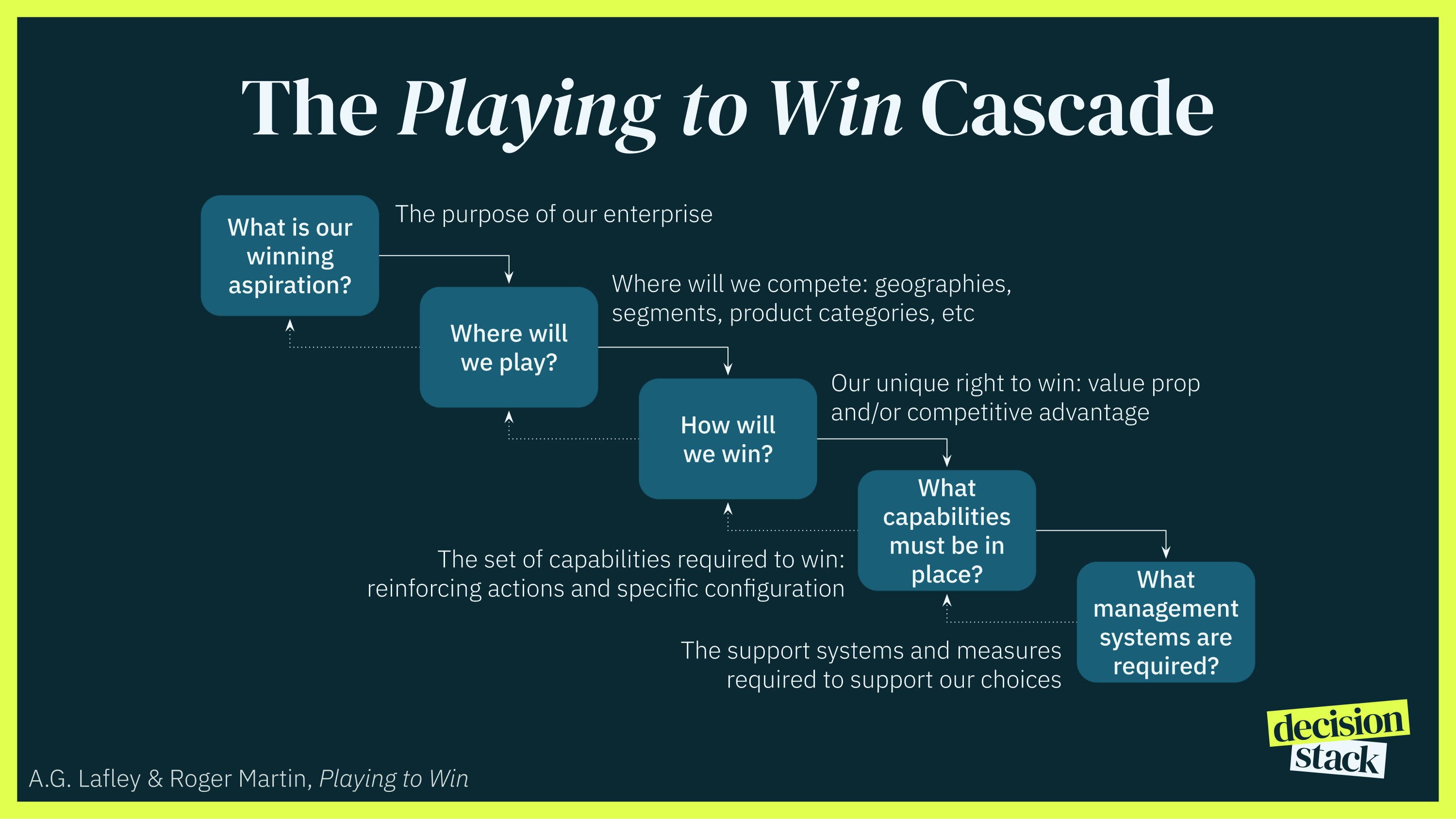
The Playing to Win Cascade is a strategic framework from the book Playing to Win, providing a structured approach for developing your strategy. The cascade consists of five key questions that should guide your decisions:
What is our winning aspiration? This question focuses on defining the organisation's overarching goal or purpose, clarifying what success looks like, and setting ambitious yet achievable objectives.
Where will we play? Here, the organisation identifies the specific markets, customer segments, and geographic regions where it will compete. This involves making strategic choices about the scope and boundaries of the business - and importantly should highlight where you will not compete.
How will we win? This question involves determining the unique value proposition and competitive advantages that will enable the organisation to succeed in its chosen markets. It requires identifying sources of differentiation and competitive advantage.
What capabilities must be in place? This question addresses the internal capabilities and resources needed to execute the strategy effectively. It involves assessing the organisation's strengths and weaknesses and identifying areas for investment and development.
What management systems are required? Finally, this question focuses on the organisational structures, processes, and systems needed to support strategy execution and ensure alignment throughout the organisation. It involves establishing clear accountability, decision-making processes, and performance metrics.
By systematically addressing these five questions, you can develop clear, coherent, and actionable strategies, and the framework helps strategic thinking and decision-making at all levels of the organisation.
Tools to Test Your Strategic Hypothesis
Just like any product hypothesis, you have to test your strategic ideas as quickly, cheaply, and low-risk as possible in order to validate them - before you spend a lot of time or capital trying to implement them.
Testing Business Ideas
7 out of 10 new products fail to deliver on expectations. Testing Business Ideas aims to reverse that statistic - David J Bland’s practical guide contains a library of hands-on techniques for rapidly testing new business ideas. Testing Business Ideas explains how systematically testing business ideas dramatically reduces the risk and increases the likelihood of success for any new venture or business project. It builds on the popular Business Model Canvas and Value Proposition Canvas books by integrating assumptions mapping and other powerful lean startup-style experiments.
Understanding Design Thinking, Lean, and Agile
A (free!) 70 page quick-read, Understanding Design Thinking, Lean, and Agile by Jonny Schneider takes you through the mindsets, methods, and how to bring it all together when leading digital product teams. It’s succinct, light on theory, and packed with loads of practical guidance, based on applied learning from doing the work.
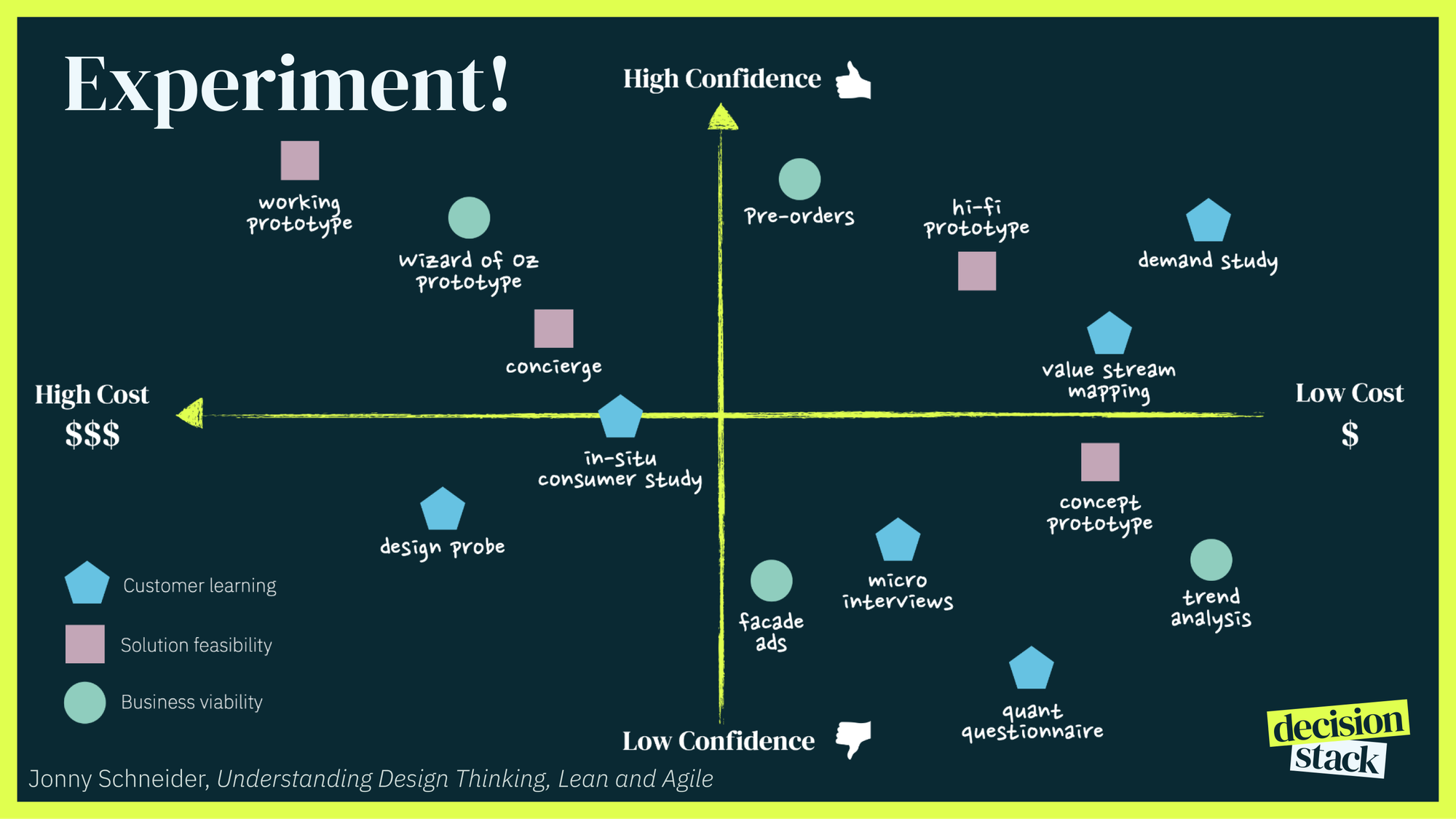
A toolkit is never complete
Make the Tools Work for You
No matter which tool you use - make sure you make them work for you. Just because they’re written a certain way or for a certain industry doesn’t mean you can’t adapt them to your own context. A great example is the Playing to Win Cascade above - it’s obviously designed for a for-profit consumer goods context but that doesn’t mean you can’t tweak it to fit a non-profit organisation or a software business. Don’t be afraid to adapt and remix any of these tools - including the Decision Stack itself! - to your needs.
Keep editing your toolkit
These are just my favourite tools and frameworks but there are many, many more that could help you in your strategic discovery and implementation. Being open to new tools, frameworks, and ideas - and knowing when to pull which tool out of the toolbox (or when to throw an old tool out) is one of the keys to excelling at strategy.
What are your favourite tools and frameworks? What have I missed?
